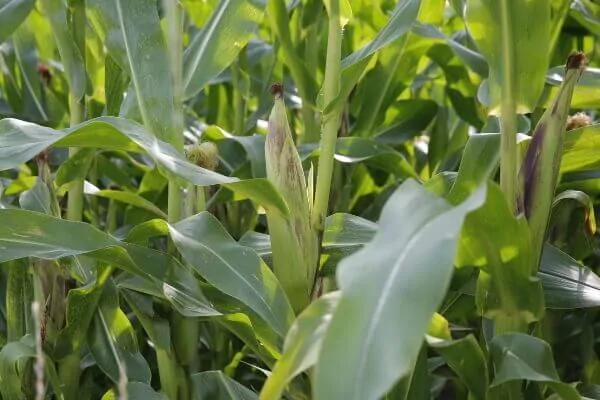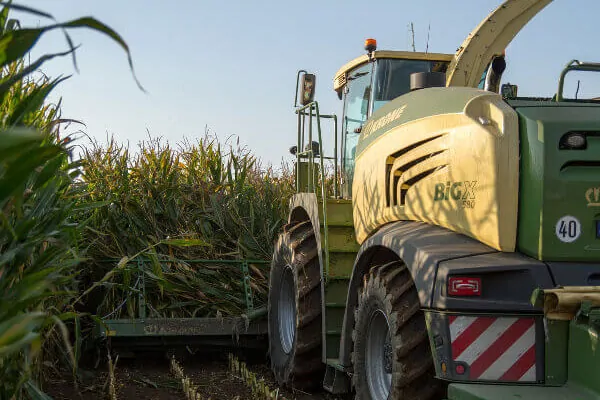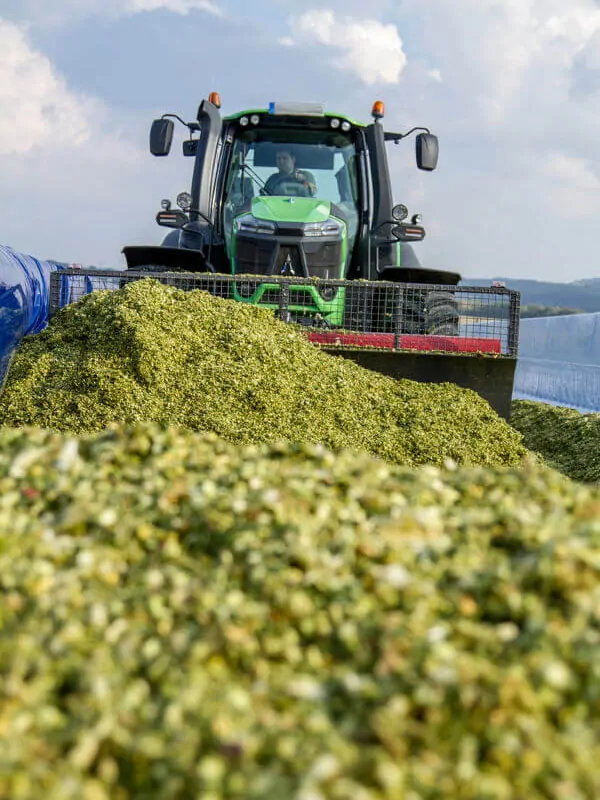Corn silage – What should be kept in mind
Every year it is important to bring the corn into the silo. The silage needs to remain cool and fresh because the cows do not need a warm meal. You can find out what to consider when harvesting corn here.
Contents
The maturity development of corn plants
Corn silage is an ideal feed raw material for ruminants.
High-quality corn silage is tasty and increases the basic feed intake. It also combines a good crude fibre content with a high energy content. You need to know the development status in the field to be able to determine the optimum stage of maturity of the corn plant. Ripening follows the date of sowing (variety) and the weather.
The dry matter content of the plant can lose up to half a percent depending on the weather. The right time of harvest is therefore different every year. The aim is a dry matter content of corn plants of 30–35%; the cob dry matter content should be 50–60%.
The maturity development of corn plants in three stages:
- Milk maturity
- Dough maturity
- Grain maturity

The development of the grain or the “milk line” provides an indication of this. It separates the liquid from the solid part of the grain. The solid part of the grain should take up half or two thirds of the grain at silage maturity (beginning to middle of dough maturity). The grain dry mass is then 63–64%, and the dry matter content in the piston is 45–55%. However, because the different maturity development processes of grain and residual plant, grain maturity can only be a guide in determining the optimum harvest time for silage corn. This results in a dry matter content of 30–35% of the total plant. Varieties with slow plant maturity development only reach their optimum in the range of 37–38% dry matter content
Target values for optimum corn silage
| Dry matter of the whole plant | 30 – 35% |
| Raw protein | 70 – 90 g/ kg dry matter |
| Crude fibre | 170 – 200 g/ kg |
| net energy lactation | over 6.5 MJ NEL / kg dry matter |
| Starch and residual sugar | over 300g / kg dry matter |
| NDF | 35 – 40% in dry matter |
The right time to harvest
Harvesting at the recommended stage of “dough maturity” brings the most advantages.
Quick lactic acid fermentation is achieved by good compaction and substances with sufficient potential for fermentation (starch, sugar). The result is tasty and energy-rich corn silage. This is also valid for the use of a heterofermentative means of silageto protect it from aerobic spoilage from yeasts and moulds.

What happens if the harvest is too early?
A too early harvest leads to low yields. Additionally, the energy content is reduced. High loss of conservation may also occur from fermented liquid.
What happens if the harvest is too late?
Late harvest causes problems with filling and compaction of the silo. Hard plant parts are more difficult to compact, therefore they increase the risk of reheating and mould formation.
Solutions for a perfect harvest
Lower dry substance contents lead to leachate and can hinder the ensiling process which leads to a loss of nutrients.
The usage of biological silage inoculants help here. The biological silage inoculant accelerates the lowering of the pH value and thus reduces nutrient losses and the propagation of fermentation pests. At the same time, heterofermentative lactic acid bacteria ensure good silage stability.
The optimal ensiling technology
Chaff length
The optimum cutting height is in the range of 2-3 inches. Above all, this depends on the level of maturity of the plant. The higher the dry material content, the shorter the plant should be chopped to ensure good compaction. However, chaff lengths that are too low run the risk of negatively influencing the structural effect of the corn silage in the rumen. The setting of the grain cracker also needs to be checked because only corn grains that have been struck can be digested by the cow.
Compacting
The most important thing during ensiling is the compaction in the silo stock. Here it is important that the roller tractor and not the forage harvester driver determine the harvest speed in the field. A storage density of more than 550lbs/dry material per m³ of silage should be used as a guide. This is achieved by a max. compacting layer height of 8-11 inches.. The weight of the roller verhicle should be a fourth of the hourly harvest tonnage. For modern cutting output, it is often useful to use two roller vehicles or to fill two silos at the same time.

The use of Josilac® in the corn harvest
You might be interested in the following contents:
Contact & Service
Would you like detailed information or a consultation? The more precisely you specify what interests you, the better we can assist you. Are you interested in purchasing Josilac® silage inoculants? We are glad to put you in touch with our dealer near you. Just send us a message with your request.